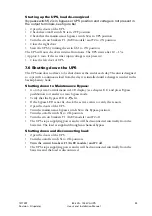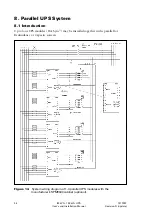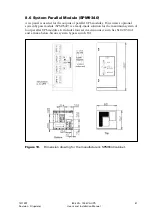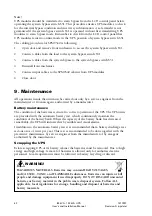
80 kVA - 130 kVA UPS
User’s and Installation Manual
1017397
Revision D (update)
42
Note!
UPS modules should be transferred to static bypass from the LCD control panel before
operating the system bypass switch S51. This procedure ensures UPS modules to check
for the internal bypass condition and inverter synchronization. A safe transfer is not
guaranteed if the system bypass switch S51 is operated without first transferring UPS
modules to static bypass mode. Remember to check from the LCD control panel that
UPS modules return to online mode in the ‘UPS’ position of system bypass switch S51.
The cabling procedure for SPM9340 is following:
1.
Open door and remove front mechanics to access the system bypass switch S51.
2.
Connect cables from the load to the system bypass switch S51.
3.
Connect cables from the system bypass to the system bypass switch S51
4.
Reinstall front mechanics
5.
Connect input cables to the SPM9340 cabinet from UPS modules.
6.
Close door
9. Maintenance
All operations inside the unit must be carried out only by a service engineer from the
manufacturer or from an agent, authorized by a manufacturer.
Battery maintenance
The condition of the batteries is crucial to correct operation of the UPS. The UPS units
are provided with the automatic battery test, which continuously monitors the
condition of the battery bank. When the capacity of the battery bank has decreased
remarkably, the UPS will indicate this by audible and visual alarms.
In addition to the automatic battery test it is recommended that a battery discharge test
is done once or twice per year. This test is recommended to be done together with the
preventive maintenance by service engineer from the manufacturer of by an agent
authorised by the manufacturer.
Scrapping the UPS
Before scrapping UPS or its battery cabinet the batteries must be removed. Due to high
energy and high voltage, removal of batteries is allowed only for authorised service
personnel. Local requirements must be followed in battery recycling or discard.
WARNING!
HAZARDOUS MATERIALS. Batteries may contain HIGH VOLTAGES,
and CAUSTIC, TOXIC and FLAMMABLE substances. Batteries can injure or kill
people and damage equipment if used improperly. DO NOT DISCARD unwanted
batteries or battery material in the public waste disposal system. Follow ALL
applicable, local regulations for storage, handling and disposal of batteries and
battery materials.





































